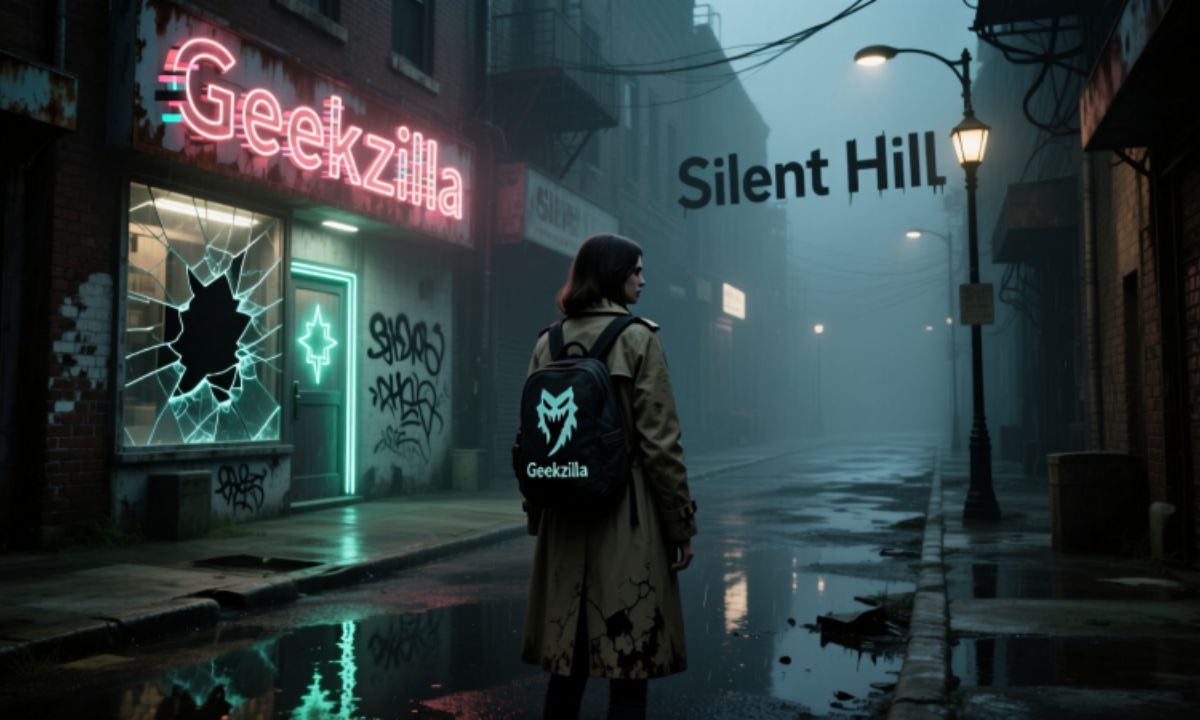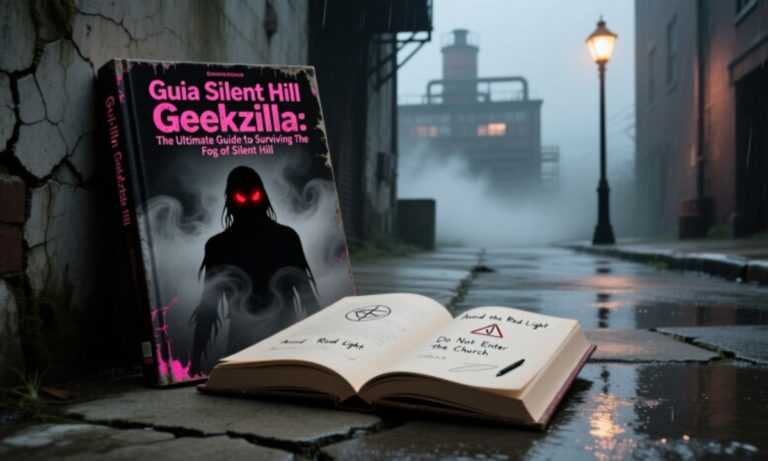Guia Silent Hill Geekzilla: Enhance The Haunted Streets & Dark Secrets
Silent Hill is more than a horror game. It is a place where fear, mystery, and hidden stories come alive. With foggy streets and eerie sounds, every step feels uncertain. That is where guia silent hill geekzilla becomes your best companion.
This guide helps you move through the haunted streets with ease. It shares dark secrets, survival tips, and character insights. Whether you are new to Silent Hill or a long-time fan, it gives you everything you need. Dive in and embrace the chilling world that never stops haunting players.
What is Guia Silent Hill Geekzilla?
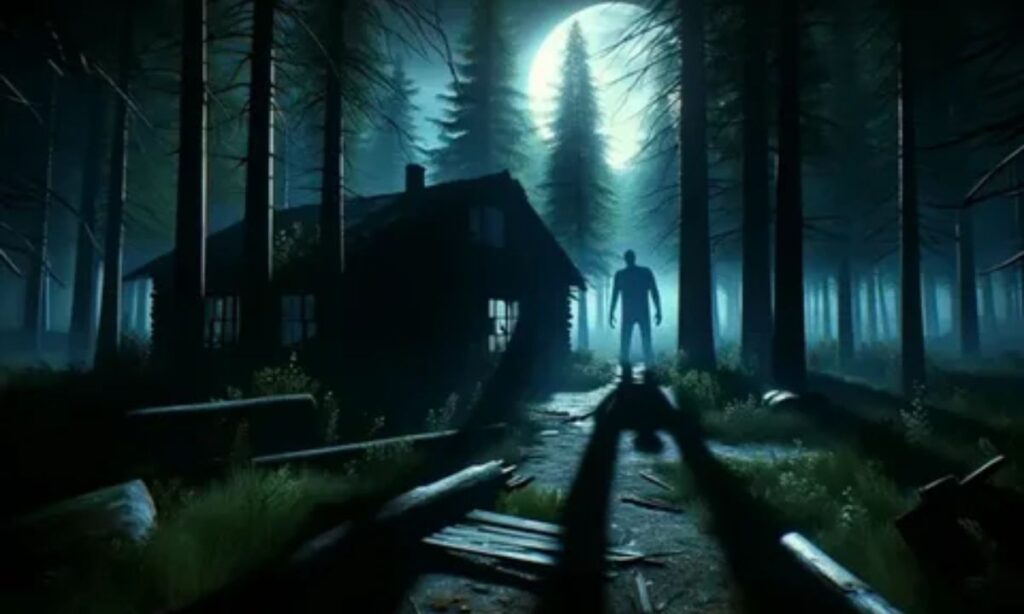
Guia Silent Hill Geekzilla represents the ultimate companion for navigating one of horror gaming’s most terrifying experiences. This comprehensive guide serves as your roadmap through the fog-laden town where nightmares become reality. For horror fans seeking to unravel the mysteries of this cursed town, this resource provides essential survival tips, puzzle solutions, and deep insights into the disturbing lore that makes Silent Hill unforgettable.
The term “guia” translates to “guide” in Spanish and Portuguese, making this an international resource for the global horror gaming community. Geekzilla brings expert analysis and detailed walkthroughs that help players survive the chilling encounters awaiting in those abandoned streets. Whether you’re a newcomer facing your first venture into the darkness or a veteran seeking hidden meanings, this guide illuminates the path through psychological horror’s masterpiece.
Understanding Silent Hill requires more than basic gameplay knowledge. The series blends survival horror mechanics with profound psychological depth, creating an experience that lingers long after the console powers down. This guide unpacks everything from character backstories to fan theories, ensuring you grasp both the surface terror and the deeper symbolism woven throughout this iconic horror series.
The Haunting Atmosphere of Silent Hill
The oppressive fog, decaying environments, and spine-chilling soundscape of Silent Hill create an atmosphere of dread that has defined psychological horror gaming for over two decades.
Fog and Darkness: The Town’s Signature Elements
The eerie atmosphere of Silent Hill begins with its most recognizable feature: the thick, impenetrable fog. This isn’t mere weather it’s a living presence that conceals terrifying monsters and transforms familiar streets into labyrinths of dread. The fog creates limited visibility, forcing players to rely on their flashlight survival instincts while the eerie soundscape fills every moment with tension.
Darkness in Silent Hill operates as both obstacle and storyteller. The disturbing environments shift between the normal world and the nightmarish “Otherworld,” where rust, blood, and decay replace ordinary structures. These transitions happen without warning, plunging players into hellscapes where haunted buildings reveal the town’s true nature. The darkness isn’t just visual, it represents the psychological trauma carried by the characters themselves.
The town’s abandoned nature amplifies the horror. Empty shops, silent homes, and deserted hospitals create an unsettling visual landscape where isolation becomes oppressive. Every footstep echoes through haunted streets, and the absence of normal life makes each encounter with nightmarish creatures feel utterly hopeless. This environmental storytelling makes Silent Hill more than a setting it becomes a character itself.
Sound Design That Pierces the Soul
Chilling music composer Akira Yamaoka created arguably gaming’s most disturbing soundtrack. The eerie soundscape combines industrial noise, haunting melodies, and unnerving silence to keep players perpetually off-balance. Radio static signals approaching danger, creating Pavlovian dread that makes your heart race before threats even appear.
The audio design extends beyond music to environmental sounds. Distant sirens, scraping metal, crying children, and whispered voices create a tapestry of terror. These elements work together to maintain constant psychological pressure, ensuring players never feel safe even in seemingly empty areas. The sound often becomes more frightening than what players actually see.
Tips for Surviving and Exploring the Town
Navigating Silent Hill’s treacherous fog-shrouded streets requires more than courage master these essential survival tactics, combat strategies, and puzzle-solving techniques to endure the town’s nightmarish horrors and uncover its darkest secrets.
Essential Survival Tactics for Beginners
Survival horror mastery begins with resource management. Ammunition remains scarce throughout Silent Hill, forcing careful decisions about when to fight and when to flee. Conserve bullets for unavoidable confrontations, especially against boss enemies. Many nightmarish creatures can be avoided entirely through strategic navigation and understanding enemy patterns.
Your flashlight survival depends on understanding its dual nature. While illuminating the darkness, it also attracts hostile attention. Toggle it off when sneaking past enemies or when you hear approaching threats. The radio serves as your early warning system—that distinctive static means danger lurks nearby. Never ignore this crucial survival tool.
Health management requires constant vigilance in this survival horror game. Healing items are limited, so take damage seriously. Explore thoroughly to find hidden items including health drinks, first aid kits, and ammunition caches. Check every drawer, cabinet, and corner. The developers rewarded thorough exploration with resources that make survival possible.
Navigation and Puzzle Solutions
Game walkthrough experts emphasize map utilization. Your in-game map marks areas automatically, crossing out completed rooms and highlighting unsolved objectives. This system prevents aimless wandering through the fog-laden town. Study the map frequently, noting locked doors that might open later with specific keys or items.
Puzzle solutions range from straightforward to mind-bendingly complex. Many puzzles incorporate symbolism related to the town’s disturbing lore and character backstories. Take notes on riddles, examine all documents thoroughly, and photograph clues if playing modern versions. Shakespeare puzzles, piano riddles, and cryptic poems all require patience and lateral thinking.
| Survival Priority | Action Required | Resource Type |
| Combat Readiness | Conserve ammunition | Bullets, weapons |
| Health Management | Collect healing items | First aid, health drinks |
| Navigation | Study map frequently | Map updates, keys |
| Puzzle Solving | Document all clues | Notes, photographs |
| Exploration | Check every location | Hidden items, supplies |
Combat Strategies Against Monsters
Understanding terrifying monsters means recognizing their weaknesses. Nurses move slowly but attack viciously in groups. Maintain distance and use melee weapons to conserve ammunition. Pyramid Head, one of gaming’s most iconic villains, appears in specific story moments you cannot defeat him permanently, so focus on survival during these encounters.
Different enemies require different approaches:
- Lying Figures: Approach from behind, use pipe or plank
- Nurses: Create distance, headshots are most effective
- Mannequins: Fast but fragile, melee attacks work well
- Abstract Daddy: Stay mobile, use all available ammunition
- Pyramid Head: Run and hide, combat is futile
Boss battles demand preparation. Stock full health and maximum ammunition before triggering obvious boss arenas. Learn attack patterns through observation. Most bosses telegraph their moves, giving windows for counterattacks. Patience defeats aggression in these chilling encounters.
Unveiling Dark Secrets: Plot and Characters
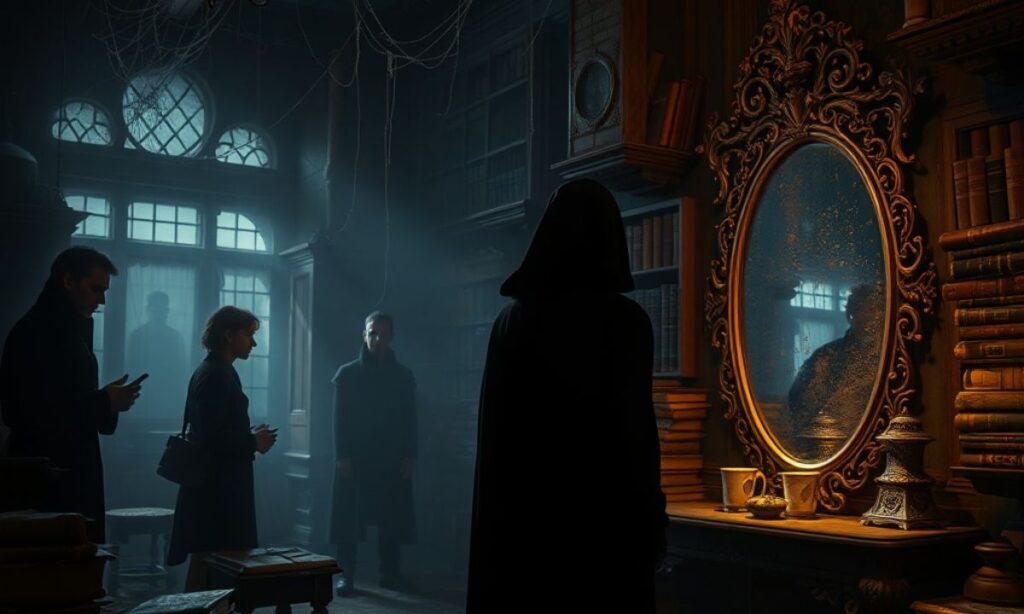
Unveiling Dark Secrets: Plot and Characters Beneath the suffocating fog and nightmarish creatures lies Silent Hill’s true horror: deeply flawed characters confronting unbearable truths about guilt and grief, where every encounter reveals another layer of the town’s disturbing lore and the psychological demons that bind tortured souls to this cursed town.
James Sunderland and the Journey of Guilt
James Sunderland, protagonist of Silent Hill 2, represents the series’ peak in psychological horror. He arrives in Silent Hill after receiving a letter from his deceased wife Mary. The journey transforms from searching for answers into confronting unbearable truths about guilt and grief. James embodies the series’ exploration of psychological trauma and human darkness.
The dark narrative reveals James murdered Mary, who suffered from a terminal illness. Unable to cope with her deteriorating condition and the strain on their relationship, James smothered her with a pillow. His mind constructed elaborate defenses against this truth, manifesting the letter and justifying his return to their “special place.”
Character backstories interweave throughout the experience. Each person James encounters mirrors aspects of his psychological struggle. Angela Orosco fled abuse and seeks death as escape. Eddie Dombrowski murdered after enduring bullying. Laura represents innocence untouched by Silent Hill’s darkness. These characters aren’t random they’re reflections exploring different responses to trauma.
Supporting Characters and Their Symbolism
Angela Orosco suffers from profound trauma related to childhood abuse. Her journey through Silent Hill manifests as flames rather than James’s rust and decay. This horror symbolism illustrates how the town adapts to each visitor’s psychological state. Angela’s tragic fate suggests surrender to trauma, contrasting James’s potential for redemption.
Maria serves as a manifestation of James’s idealized desires. She resembles Mary but dresses provocatively and acts flirtatiously—everything the sick Mary couldn’t be. Maria dies repeatedly throughout the game, forcing James to confront that this fantasy cannot replace genuine connection. She represents escapism and denial of reality.
Laura’s immunity to monsters reveals innocence’s protection from Silent Hill’s horrors. She genuinely loved Mary and possesses no guilt requiring punishment. Her perspective challenges James’s reliability as a narrator, revealing truths he’s suppressed. This technique deepens the psychological depth and questions everything players assume.
Multiple Endings and Their Meanings
The game features six possible endings determined by player actions:
- “Leave” Ending: James accepts responsibility, leaves with Laura
- “In Water” Ending: James commits suicide, unable to forgive himself
- “Maria” Ending: James chooses fantasy over facing reality
- “Rebirth” Ending: James attempts to resurrect Mary through ritual
- “Dog” Ending: Humorous reveal that a dog controlled everything
- “UFO” Ending: Aliens abduct James, comedic secret ending
Each ending reflects James’s psychological state based on how players engaged with the dark narrative. Visiting Maria frequently leads to her ending. Taking excessive damage and examining certain items triggers the suicide conclusion. These mechanics make players complicit in James’s journey, creating immersive gameplay that mirrors psychological choices.
Evolution of the Series: From Games to Movies
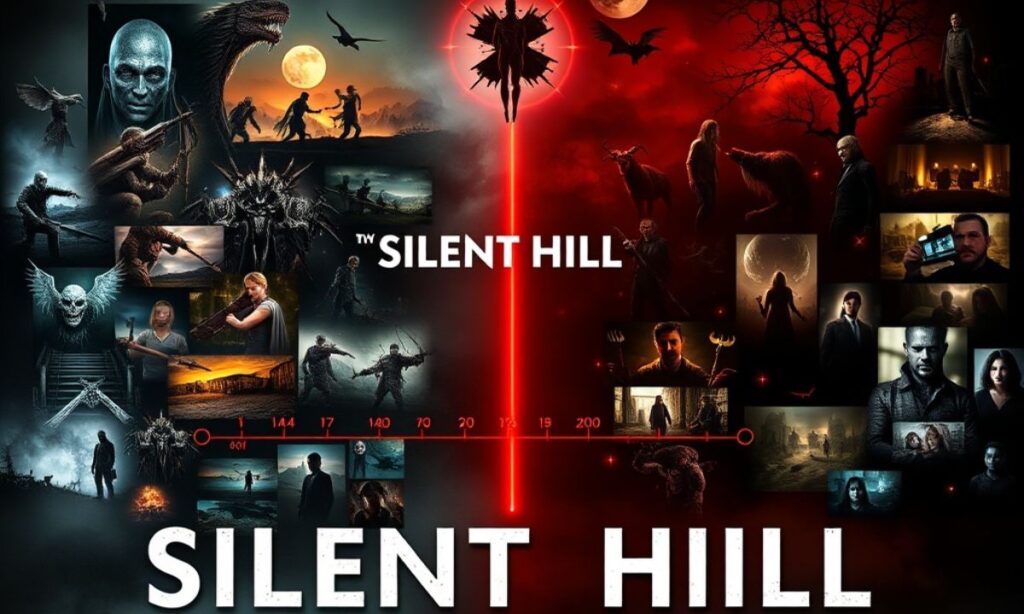
From its groundbreaking 1999 PlayStation debut to Hollywood adaptations and highly anticipated remakes, Silent Hill has transcended gaming boundaries to become a multimedia horror phenomenon. This iconic horror series has evolved through technological advances and creative interpretations while maintaining the psychological depth and eerie atmosphere that defined its legendary status in the horror gaming community.
The Gaming Legacy: From PS1 to Modern Remakes
The classic horror franchise launched in 1999 on PlayStation, introducing revolutionary survival horror mechanics. Unlike action-focused contemporaries, Silent Hill emphasized vulnerability and psychological dread. Fixed camera angles, limited resources, and complex symbolism set new standards for horror storytelling in gaming.
Silent Hill 2 (2001) elevated the formula to artistic heights. Critics and fans consider it the series pinnacle, blending gameplay with literary-quality narrative. The game explored mature themes like euthanasia, sexual frustration, and suicidal ideation with nuance rarely seen in gaming. Its influence echoes through horror media decades later.
Subsequent entries explored different aspects of the cursed town:
- Silent Hill 3: Direct sequel to the original, following Harry’s daughter Heather
- Silent Hill 4: The Room: Experimental departure featuring apartment hub
- Silent Hill: Origins: Prequel exploring the cult’s origins
- Silent Hill: Homecoming: Western-developed entry with combat focus
- Silent Hill: Downpour: Final main entry before series hibernation
Remake Speculation and Modern Revival
Remake speculation dominated horror gaming discussions for years. Konami announced Silent Hill 2 Remake developed by Bloober Team, reigniting the horror gaming community. This cinematic adaptation of the beloved classic promises modern graphics while preserving the original’s atmosphere and psychological complexity.
The remake features over-the-shoulder perspective replacing fixed cameras, updated combat mechanics, and expanded environments. Voice actors return to recapture original performances. Purists debate whether modernization enhances or diminishes the experience, but consensus agrees that introducing Silent Hill to new audiences benefits the iconic horror series.
Technical improvements showcase the fog-laden town with unprecedented detail. Ray tracing illuminates the darkness with realistic lighting, making flashlight survival more strategic. Enhanced audio design amplifies the eerie soundscape, taking advantage of modern hardware. These upgrades aim to make Silent Hill terrifying for contemporary players while honoring the original vision.
Silent Hill Movie Adaptations
The Silent Hill movie (2006) directed by Christophe Gans delivered cinema’s best video game adaptation at that time. The film captured the eerie atmosphere, faithfully recreating the visual design of haunted buildings and nightmarish creatures. Pyramid Head’s cinematic appearance became iconic, exposing mainstream audiences to the terrifying monsters.
The movie condensed and altered the game’s narrative, focusing on a mother searching for her adopted daughter. While purists criticized changes to the disturbing lore, the film succeeded in translating Silent Hill’s visual and atmospheric horror to cinema. The Otherworld transitions, the cult elements, and Akira Yamaoka’s music created an authentic experience.
Silent Hill: Revelation (2012) attempted to adapt Silent Hill 3’s story but received poor critical reception. The sequel suffered from budget constraints, weaker direction, and narrative confusion. Despite featuring more elaborate creature effects, it lacked the original film’s atmospheric dread and psychological depth, disappointing fans hoping for a worthy continuation.
Fan Theories and Speculations Surrounding Silent Hill
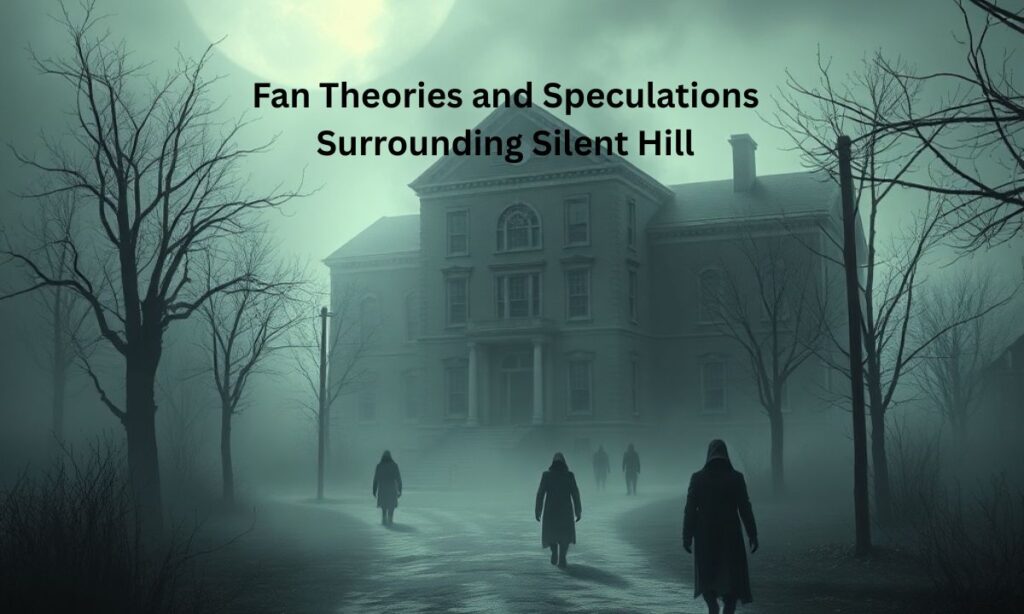
The Silent Hill community thrives on unraveling the series’ hidden meanings and disturbing lore, generating countless interpretations that keep the mysterious plots alive decades later. These fan theories explore everything from the town’s supernatural origins to character connections, demonstrating how the psychological depth invites endless analysis and debate among dedicated horror fans.
The Town’s True Nature
Fan theories debate whether Silent Hill possesses supernatural power or simply mirrors visitors’ psychologies. Some interpret the town as purgatory where guilty souls face judgment. Others view it as manifesting psychological trauma into physical reality. The cult horror game deliberately leaves this ambiguous, allowing multiple valid interpretations.
The cult’s role remains central to theories about the town’s power. Ancient rituals performed by the Order of Silent Hill awakened dark forces, creating the conditions for the haunted memories to materialize. Evidence throughout the series suggests the cult’s god, corrupted by hatred and pain, transformed Silent Hill into a prison for tortured souls.
Hidden meanings pervade every aspect of the experience. Rust represents decay and corruption. Water symbolizes purification and truth. The Otherworld’s industrial aesthetic reflects mechanistic violence and dehumanization. These horror symbolism elements create layered storytelling rewarding repeated playthroughs and deep analysis.
Character Connection Theories
Speculation surrounds whether protagonists from different games share connections. Some theories suggest all visitors descend from cult members or share bloodlines with Silent Hill’s founders. Others propose that the town selectively calls specific individuals based on guilt severity or potential for redemption.
The psychological depth invites interpretation of which events actually occurred versus hallucinations. Did James really meet Angela and Eddie, or were they projections of his fragmented psyche? Are multiple endings all simultaneously true in different dimensions? These questions generate endless discussion within the horror gaming community.
Pyramid Head theories analyze his symbolism extensively. Most agree he represents James’s desire for punishment, appearing as masculine violence reflecting James’s self-loathing. His design incorporates both executioner and sexual imagery, manifesting James’s guilt over intimate aspects of Mary’s death. His appearance in other games contradicts this specific symbolism, frustrating fans who valued the original meaning.
Community Interpretations and Debates
The horror exploration community produces remarkable interpretive content. Video essays dissect every detail, from enemy designs representing psychological states to environmental storytelling revealing backstory. These analyses demonstrate how the immersive gameplay rewards observation and contemplation beyond surface-level scares.
Debates rage over which installment deserves recognition as the best entry. Silent Hill 2 dominates critical acclaim, but passionate advocates champion the original’s pure survival horror, Silent Hill 3’s visual design, or Silent Hill 4’s experimental risks. These discussions strengthen community bonds while highlighting the series’ diverse strengths.
Remake speculation previously dominated forums, with fans proposing ideal developers, desired features, and concerns about modernization. Now that remakes are reality, discussions shift to evaluating faithfulness, debating changes, and hoping for remakes of subsequent entries. The community’s passion ensures Silent Hill remains culturally relevant despite years without new entries.
Embrace the Horror and Mystery of Silent Hill
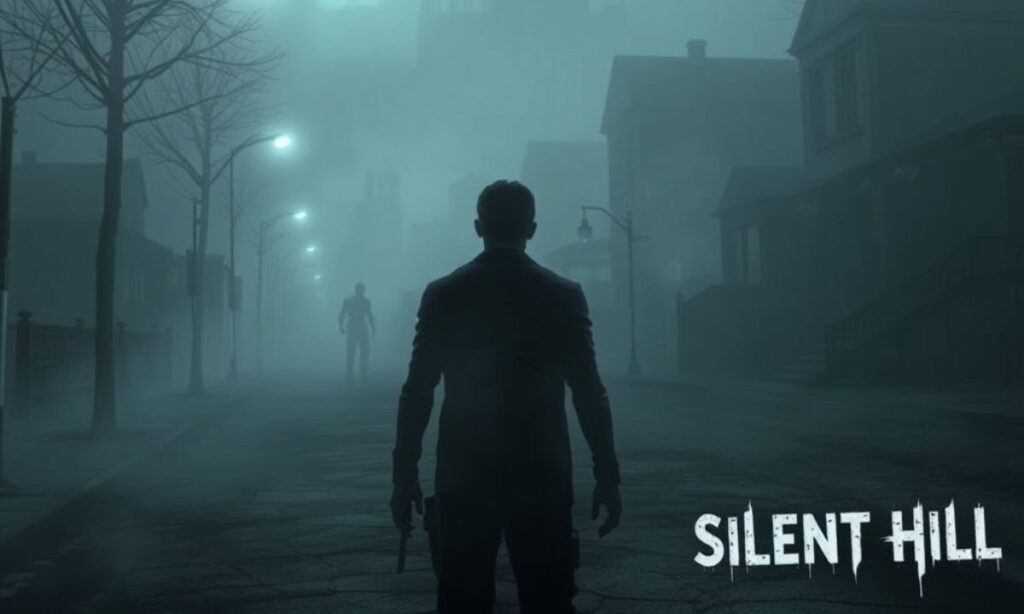
Silent Hill isn’t just a game it’s a profound psychological journey into humanity’s darkest emotions and deepest fears. This iconic horror series challenges players to confront not only terrifying monsters lurking in the fog, but the shadows within their own souls.
Why Silent Hill Remains Essential Gaming
Silent Hill transcends typical gaming experiences to achieve artistic significance. The series proves games can explore complex themes like guilt and grief, mortality, abuse, and redemption with sophistication matching any medium. The psychological trauma depicted resonates because it reflects authentic human struggles rather than superficial scares.
The survival horror game mechanics create genuine vulnerability that modern action-heavy games rarely achieve. Limited resources force meaningful choices. Weak combat keeps players afraid rather than empowered. The terrifying monsters maintain threat because you cannot simply shoot your way through problems. This design philosophy creates tension that persists throughout entire playthroughs.
Horror storytelling in Silent Hill respects player intelligence. The dark secrets aren’t explicitly explained but revealed through environmental details, documents, and symbolic imagery. This approach demands active engagement rather than passive consumption. Players become detectives piecing together mysterious plots rather than passengers on rails.
Joining the Horror Gaming Community
The horror fans community surrounding Silent Hill remains vibrant decades after the series’ peak. Online forums, Reddit communities, and Discord servers facilitate discussion about fan theories, game walkthrough strategies, and interpretations of hidden meanings. New players find welcoming environments where veterans eagerly share insights.
Content creators produce remarkable analytical work exploring every facet of the iconic horror series. Video essays, podcasts, and written analyses examine design choices, psychological themes, and cultural impact. Engaging with this content enriches understanding and appreciation, revealing layers invisible during initial playthroughs.
Horror exploration communities also produce fan content including artwork, music covers, cosplay, and even fan games. This creativity demonstrates the series’ lasting influence and the passion it inspires. Contributing to these communities through discussion, creation, or appreciation connects you with fellow enthusiasts worldwide.
Preparing for Your Journey
Before entering the fog-laden town, prepare mentally for an experience unlike typical games. Silent Hill requires patience, attention to detail, and willingness to sit with discomfort. The chilling encounters aren’t about jump scares but sustained psychological pressure that builds gradually.
Approach the survival tactics with flexibility. While guides like this provide valuable information, the most profound experiences come from personal discovery. Allow yourself to get lost in the abandoned streets. Feel the genuine fear when resources dwindle. Experience the narrative revelations firsthand before reading extensive analyses.
Most importantly, embrace the disturbing environments and unsettling visuals as integral to the artistic vision. Silent Hill isn’t pleasant, but it’s profoundly meaningful. The journey through guilt and grief, confronting personal darkness, and potentially finding redemption creates unforgettable experiences that linger long after the final credits roll.
Frequently Asked Questions
What makes Silent Hill different from other horror games?
Silent Hill emphasizes psychological horror over action, exploring deep themes like trauma and guilt through symbolism while creating genuine vulnerability through limited resources.
Do I need to play Silent Hill games in order?
Most entries tell standalone stories, though Silent Hill 3 directly continues the original. Silent Hill 2 serves as the perfect introduction for newcomers.
Why is the fog so prominent in Silent Hill?
The fog and darkness served technical purposes initially (hiding draw distance) but became iconic atmospheric elements representing psychological obscurity and uncertainty.
Is Silent Hill based on a real location?
The series draws inspiration from Centralia, Pennsylvania, an abandoned town suffering underground coal fires, though Silent Hill incorporates various influences.
What happened to the Silent Hill franchise?
Konami ceased major development after 2012, canceling promising projects including P.T. with Hideo Kojima, though recent remakes suggest potential revival.
Conclusion
Silent Hill has always been a world filled with fear, mystery, and unforgettable stories. With guia silent hill geekzilla, you get the keys to unlock hidden secrets and survive its haunted streets. From chilling encounters to deep character lore, this guide makes your journey more thrilling and complete.
Whether you are walking through the fog for the first time or returning as a long-time fan, the darkness always has something new to show. Embrace the horror, uncover the mysteries, and let every shadow reveal a story worth remembering. Silent Hill is waiting are you ready to face it?

